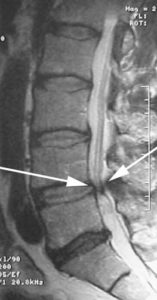What is neurogenic claudication?
Neurogenic claudication is essentially leg pain or weakness while walking that stems from the nervous system. It’s also known as pseudoclaudication. This condition can lead to difficulty walking, and your legs feeling heavy. There is another type of claudication involving the vascular system, which is caused by obstructed blood flow to the leg muscles, which may mimic some of the symptoms of the neurogenic type but is treated differently.
Lumbar stenosis with neurogenic claudication
Stenosis in the lumbar area of the spine is closely associated with neurogenic claudication. Spinal stenosis happens when the small spaces within the spine narrow, which can then compress the nerves that run through them resulting in neurogenic claudication. Pain from spinal stenosis originates in the lower back, but the pain radiates downwards throughout one or both legs. The reason for this radiating pain is due to the nerves in the back that run down through the legs, and a compression at one point in the spine will affect the connected limbs.
Causes and Risk Factors
The main cause of neurogenic claudication is spinal stenosis, which is in turn caused by wear and tear over the years or osteoarthritis. Other factors that can impact the spinal canal and spinal nerves are bulging discs, bone spurs at the facet joints, and ligaments in the spine getting thicker. Any of the causes can put pressure on nerve roots or the cauda equina, which is the group of nerves at the bottom of the spinal cord. Due to the nature of the causes of neurogenic claudication the pain is relieved by sitting down and bending forward, but are more pronounced when standing or walking.
Neurogenic Claudication Symptoms
Symptoms of neurogenic claudication effect the lower back, the buttocks, and one or both legs. These symptoms can range in intensity from mild to severe and can include:
- Pain in the Back and Legs
- Cramping
- Tingling
- Weakness or Heaviness in the Legs
When the symptoms get so bad you’re having trouble walking it’s important to consult with a medical professional to properly diagnose and treat the underlying causes.

Spinal Stenosis and Walking Problems
One of the reasons it’s important to talk to a doctor as soon as possible if spinal stenosis is suspected is because the symptoms may become worse as time goes on as the spine degenerates. Intervening with the degeneration and damage to nerves is critical to maintain normal physical activity and start relieving the pain and symptoms. Spinal stenosis can cause trouble with walking because of the weakness in the legs, but can also lead to bowel and bladder issues. The compression of the spinal cord can also cause foot pain depending on where exactly the stenosis is taking place. Symptoms might not show up right away and will come slowly over time, so getting treatment early on as they first start showing up is best if possible.
Testing and Diagnosis for Neurogenic Claudication Syndrome
The first thing your doctor will do during an initial diagnosis is a physical exam with detailed questions to help deduce the exact cause of your symptoms. Many of the symptoms that are caused by spinal stenosis can also be linked to many other back problems, spinal issues, and various other diseases or ailments. Imaging tests help more conclusively point to an exact diagnosis and pin point the location of the problem within the spine.
The imaging tests generally used to help diagnose and test for spinal stenosis include:
- X-ray – An X-ray uses electromagnetic radiation to generate an image of the bones and structures within your body.
- Magnetic Resonance Imaging (MRI) – Using a large, very strong magnet the MRI machine uses radio frequencies to produce a detailed 3 dimensional scan of the soft tissues and bones of the spine. This is particularly useful when investigating spinal stenosis or other spine issues.
- Computerized Tomography (CT) Scan – Uses a series of X-ray images from different angles around the body and a computer processes the images to create a more detailed look at the body than a typical plain X-ray.
Treating Spinal Stenosis and Neurogenic Claudication
Conservative treatments are usually the go to when starting a treatment and recovery process for neurogenic claudication. Over the counter or prescribed pain and anti inflammatory medication help as well as physical therapy. Starting out slow with exercise and stretching helps stabilize your spine and give your body the support it needs. Wearing a back brace may also help, but you’ll want to stick to the recommendation and guidance of your doctor. Spinal injections called epidural injections can relieve the symptoms of neurogenic claudication for a few months or a couple years, but should still be coupled with physical therapy or some other kind of treatment to deal with the underlying issues.
Surgery for Neurogenic Claudication
With symptoms that are very severe and debilitating to everyday life surgical options may be presented by your doctor. The goal of surgery is to decompress the parts of the spinal cord that are compressed, and provide full relief of pain and neurogenic claudication. Decompression surgery for neurogenic claudication come in many types such as foraminotomy, laminotomy and laminectomy. A foraminotomy widens the openings of the foramen, which are pathways in your spine that nerves travel through. This helps combat the spinal stenosis and the symptoms associated. Laminotomy also creates an opening to decompress the nerves, but it removes small a portion of the lamina from the problematic verterba. Laminectomy is similar to laminotomy in that it removes part or all of the lamina to accomplish decompression.


